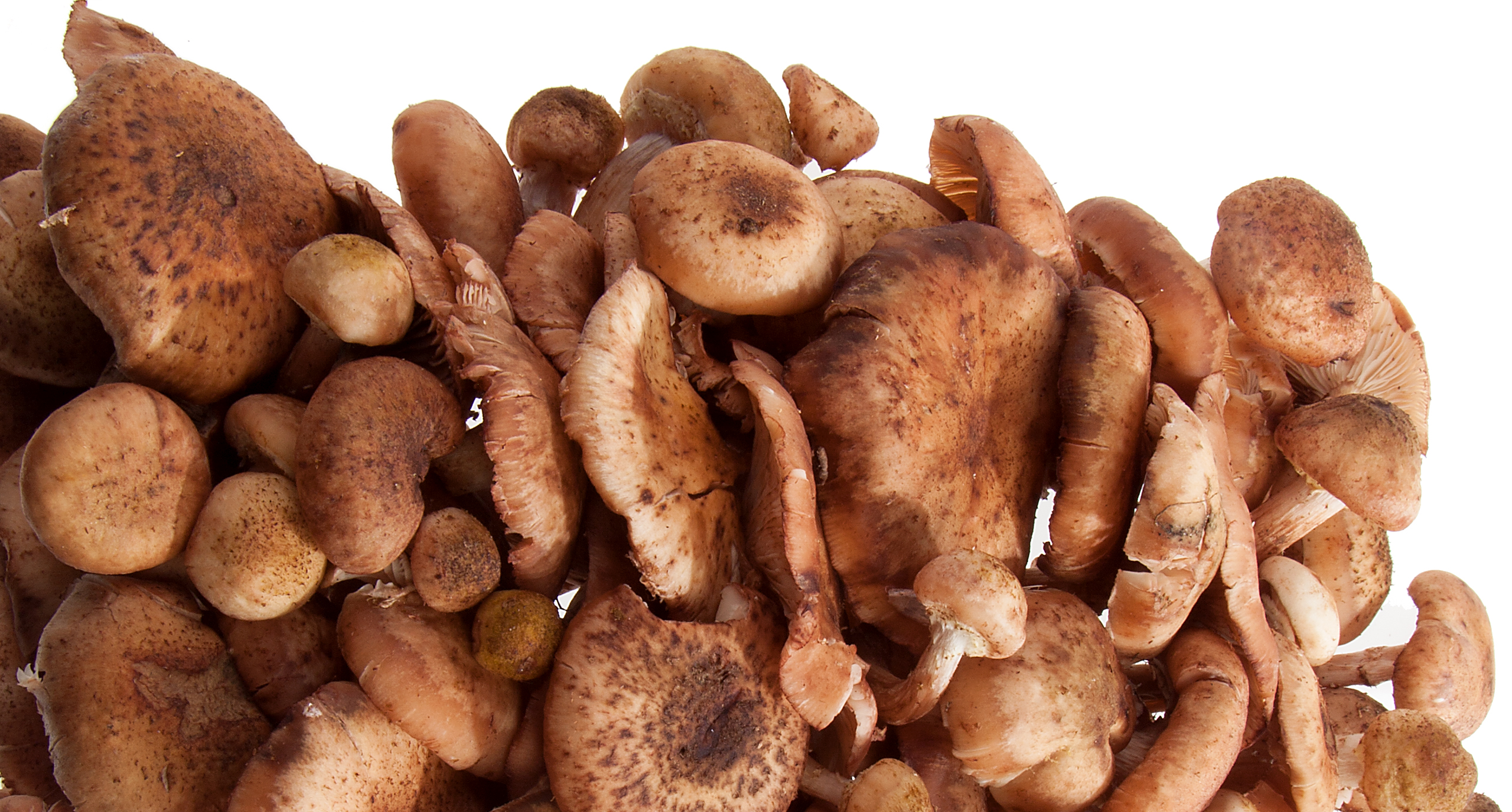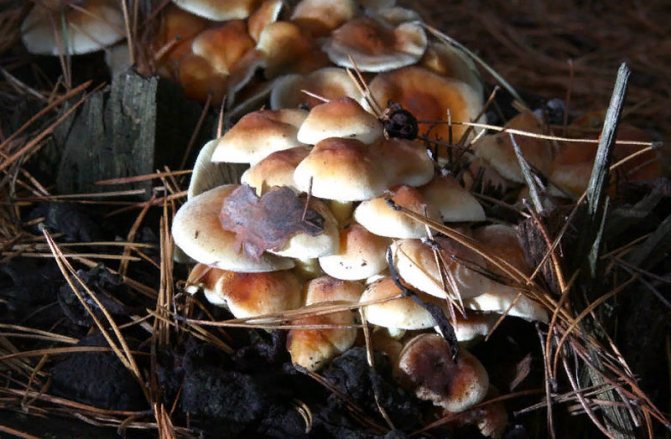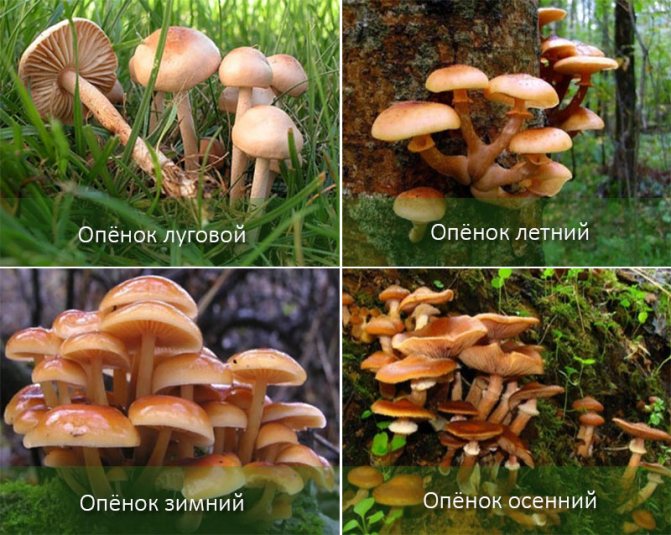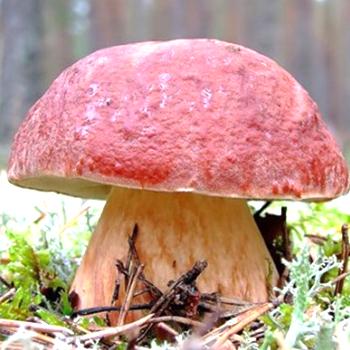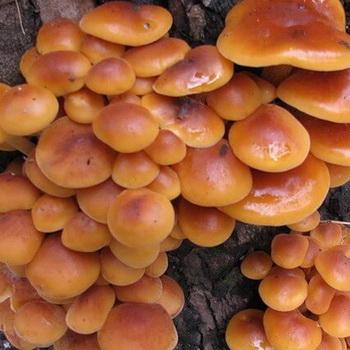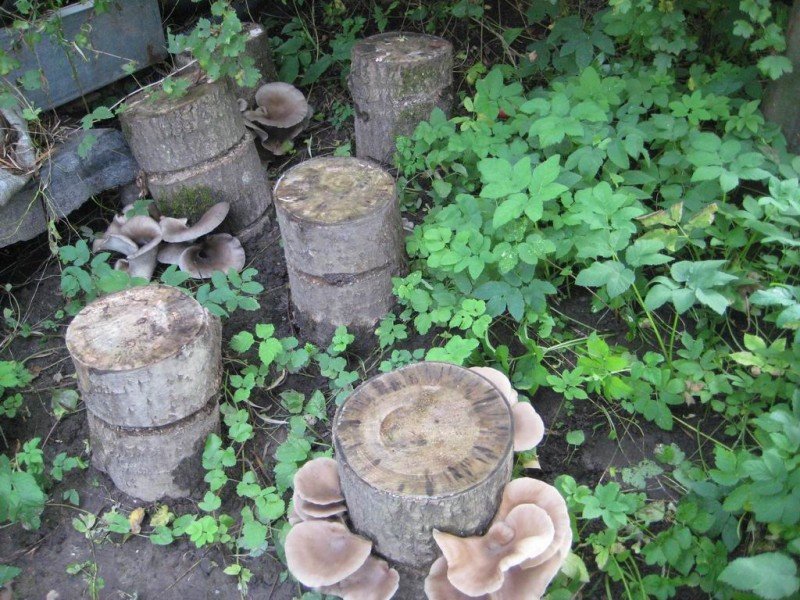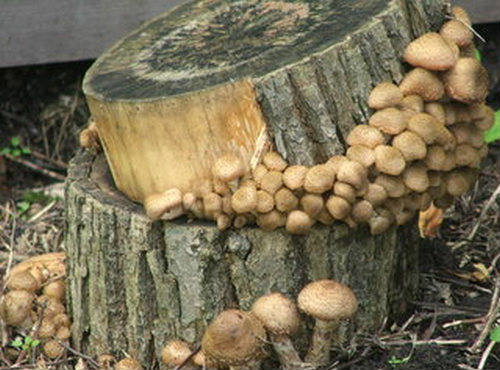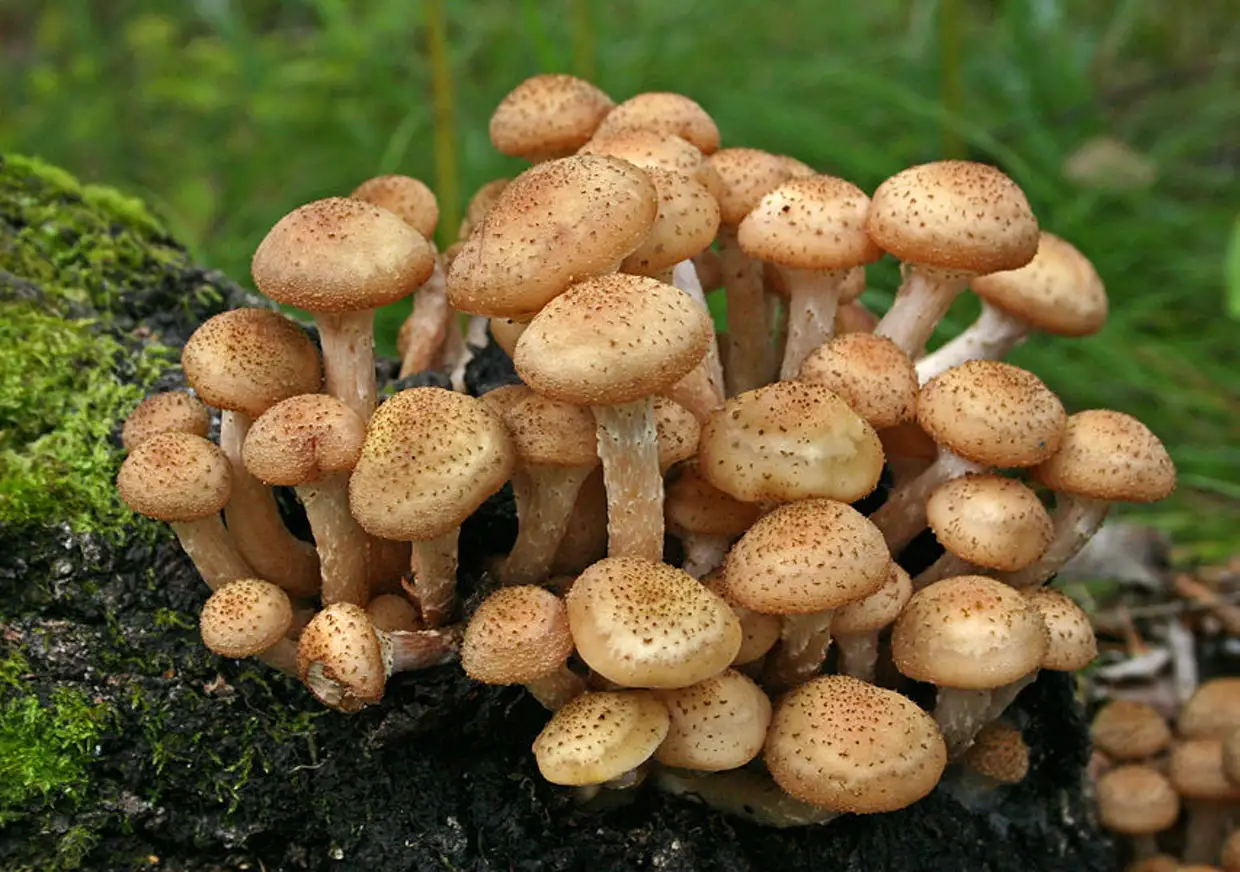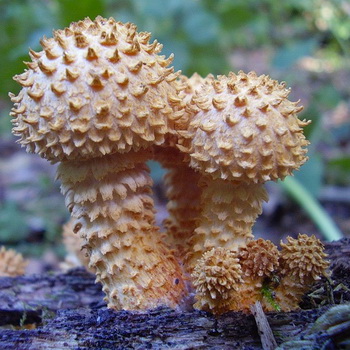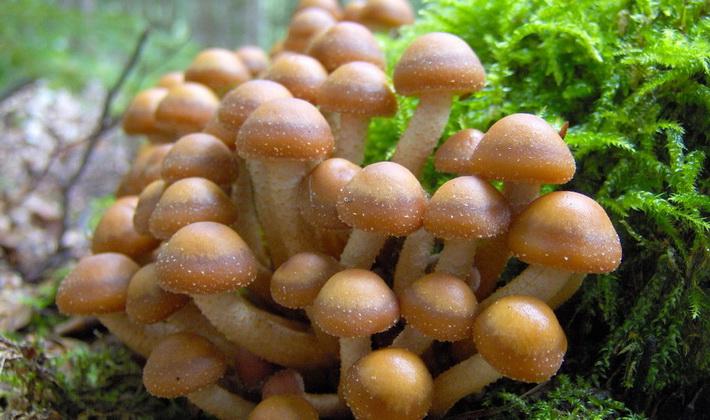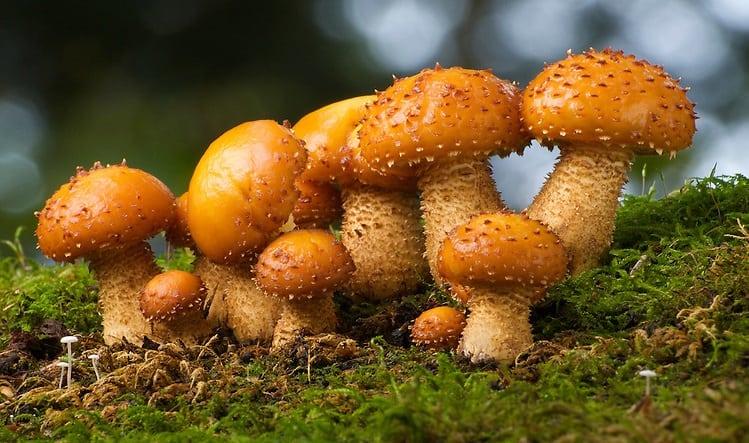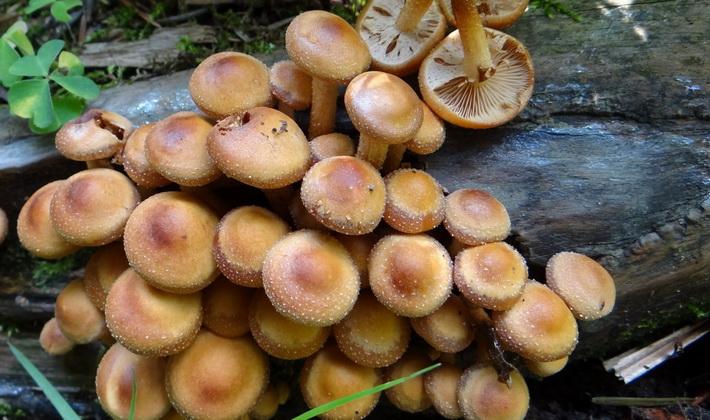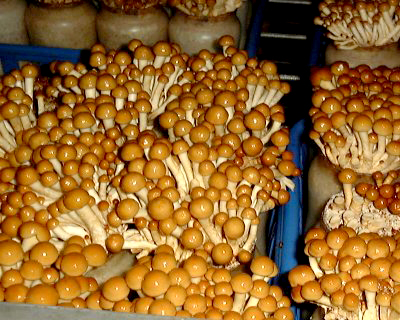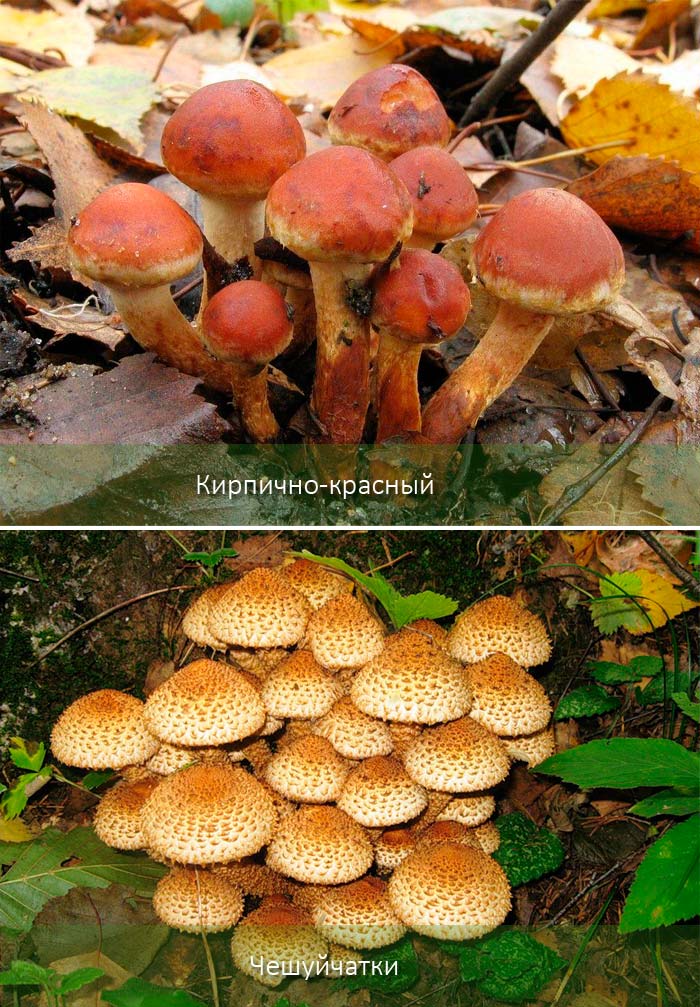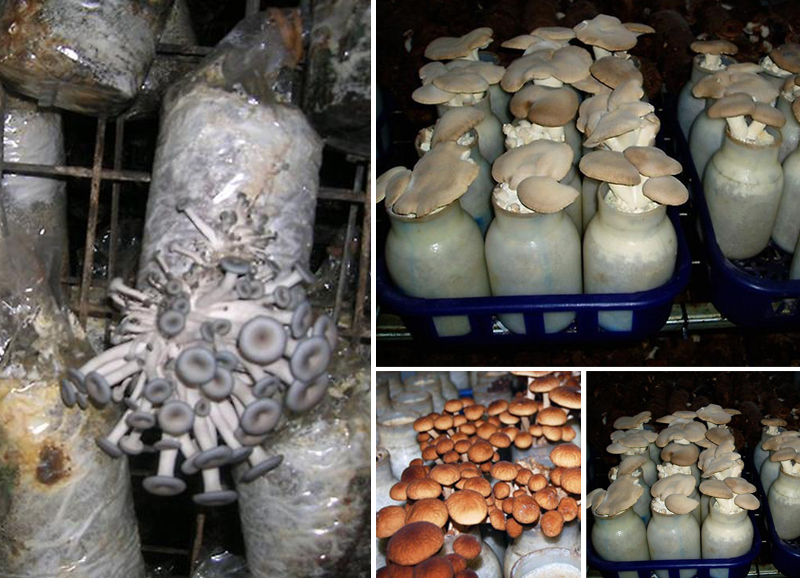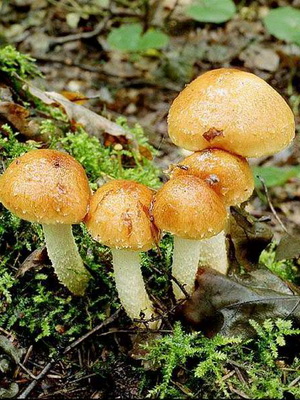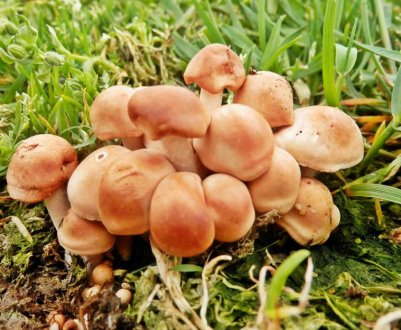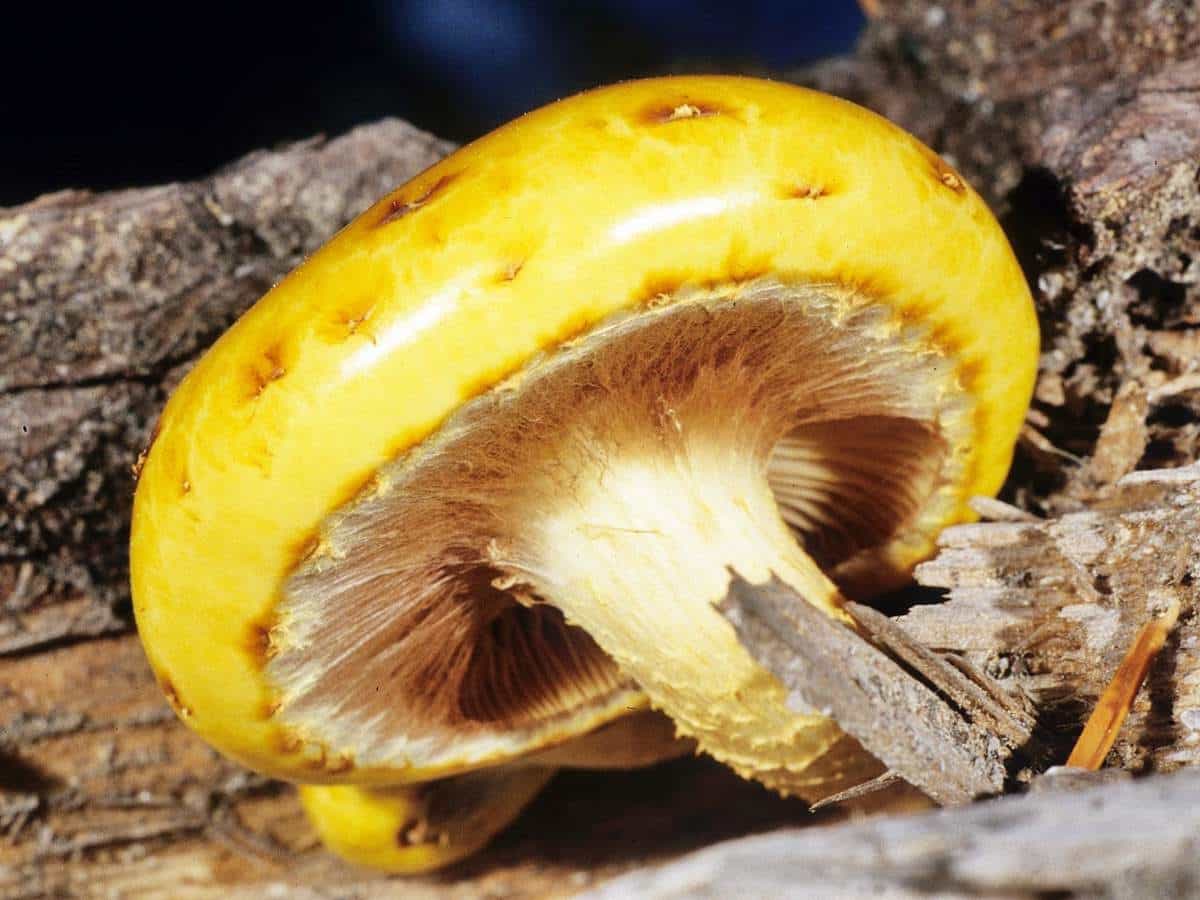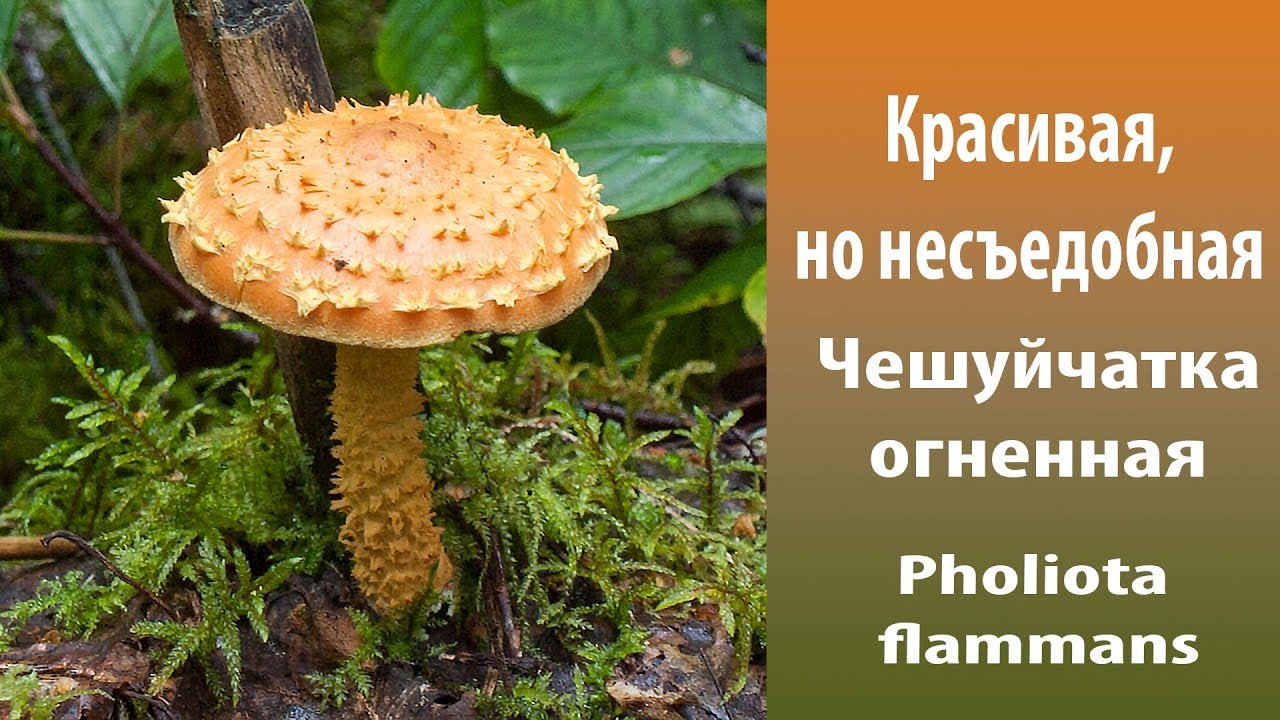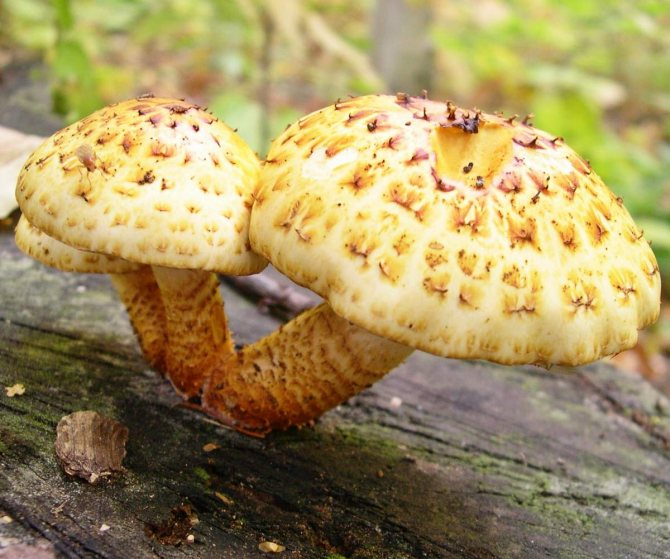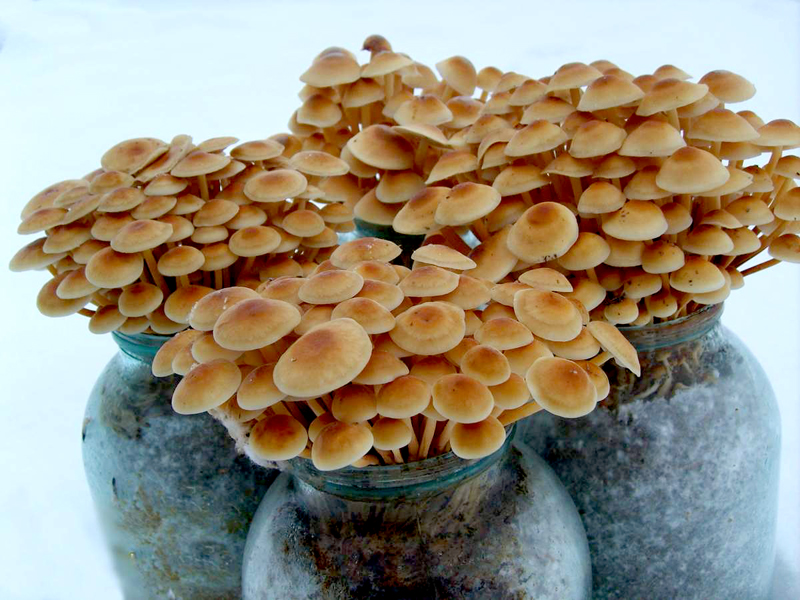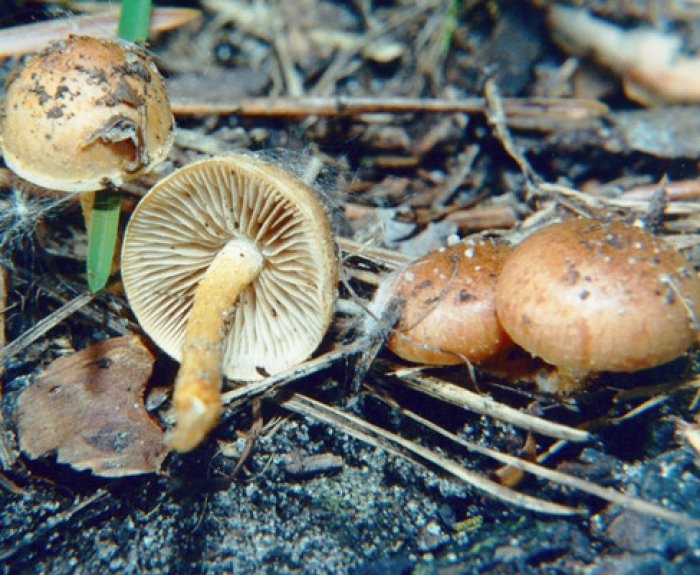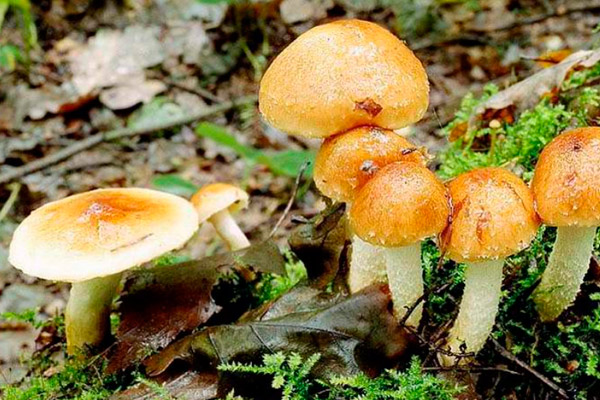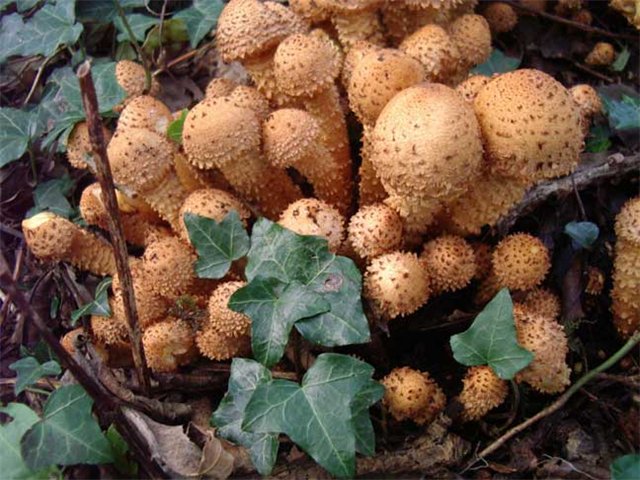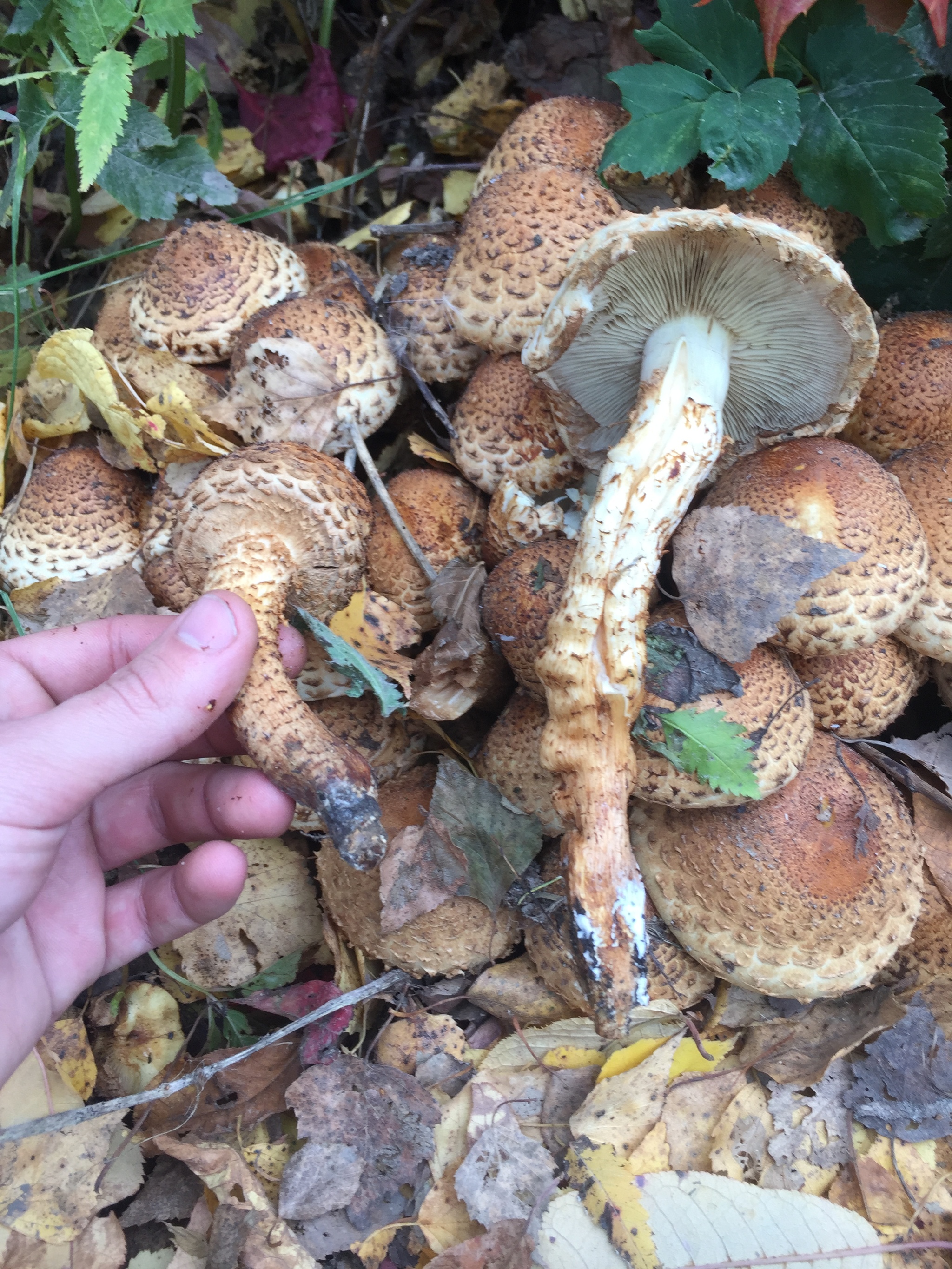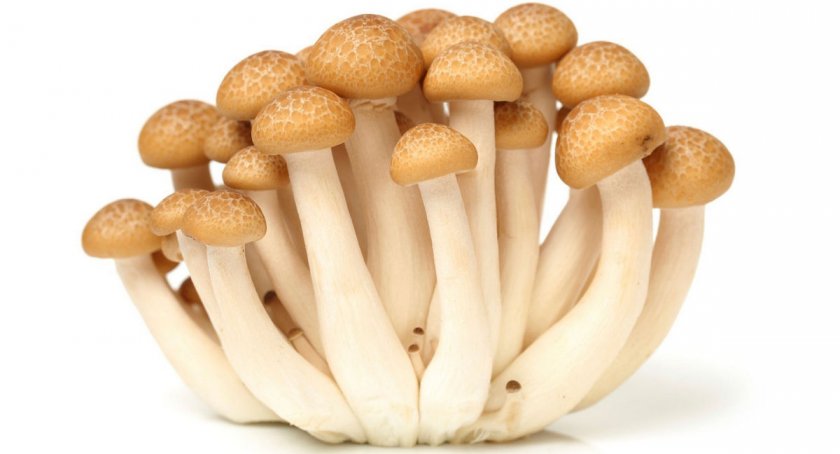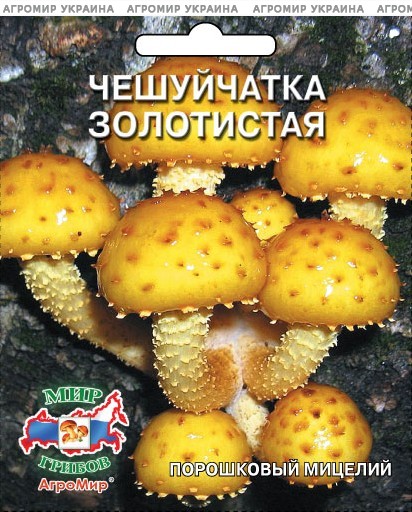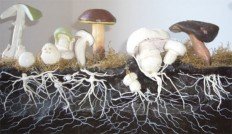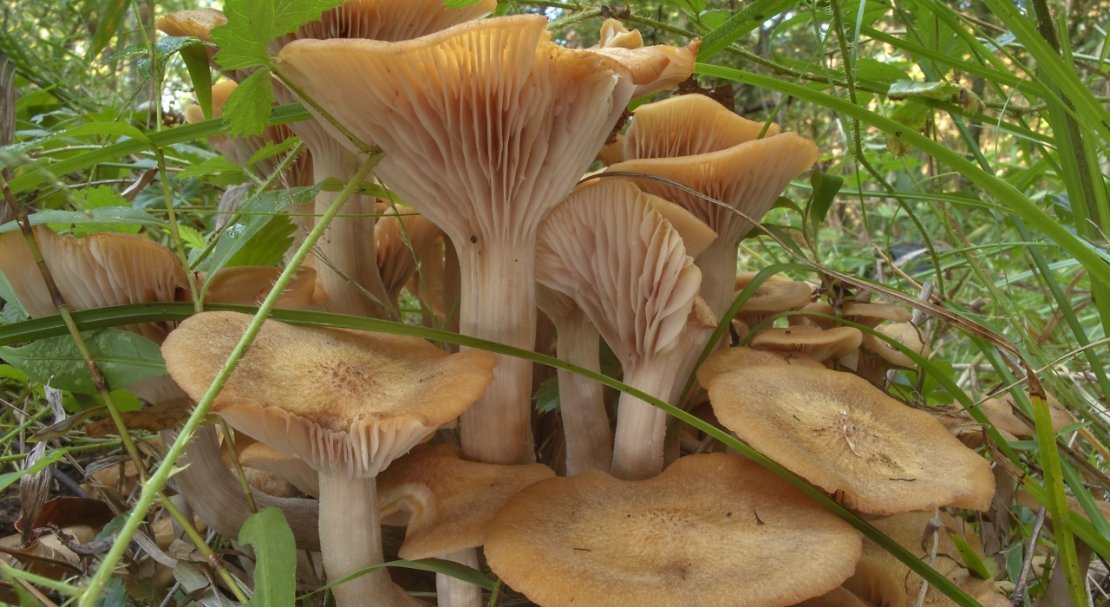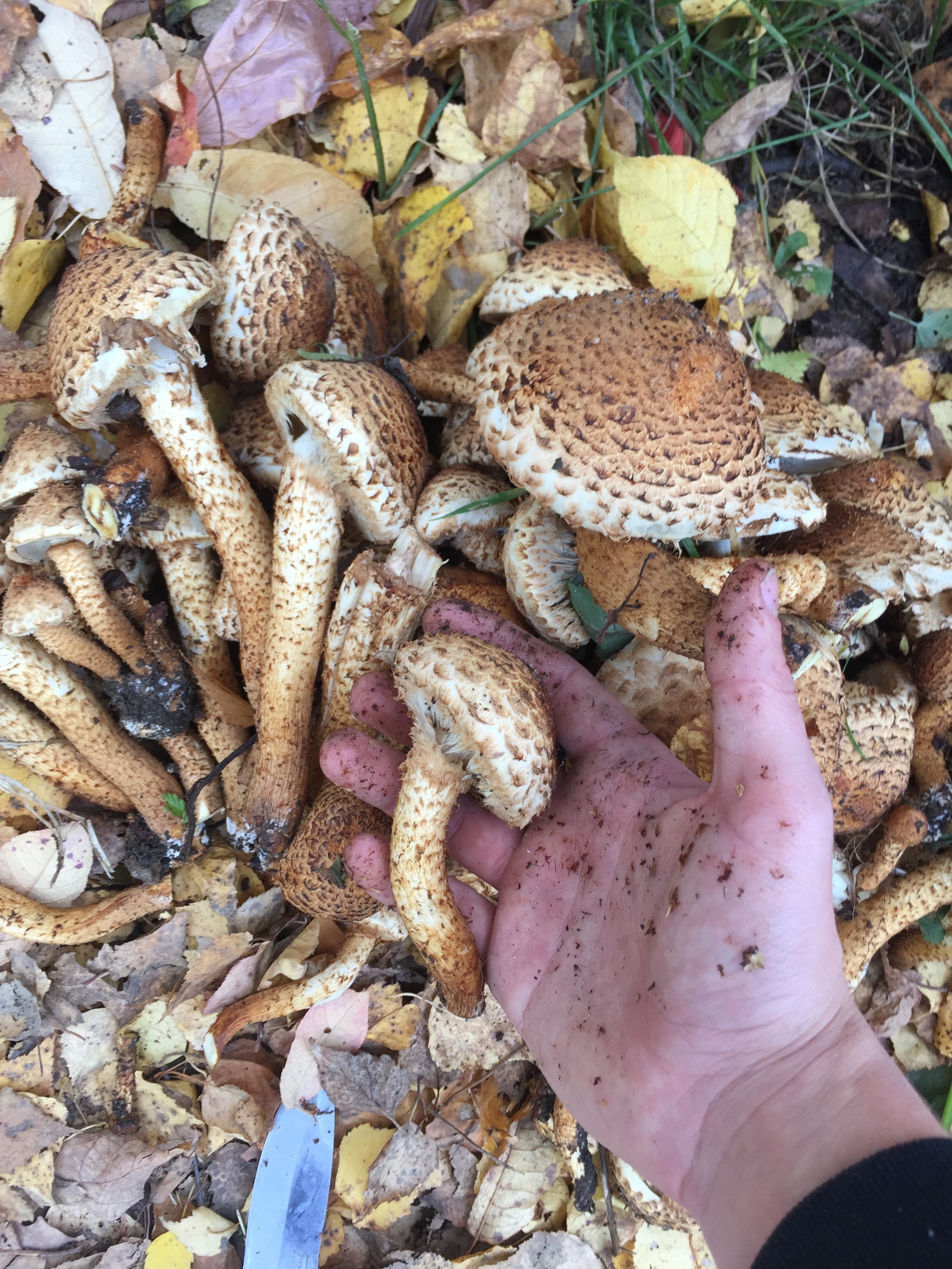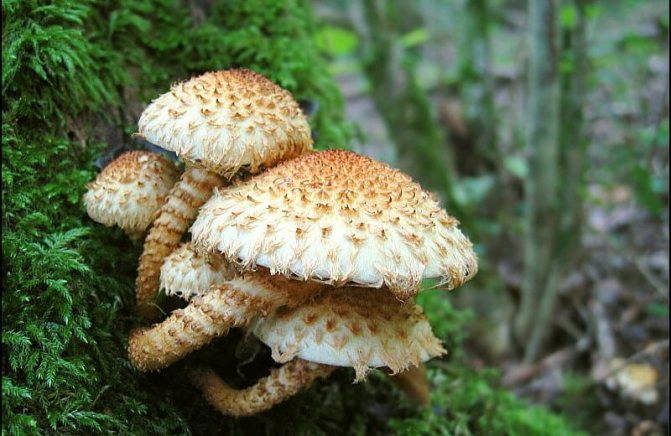Description and classification
The most popular and widespread in the CIS countries are edible and golden types of scales. Hybrids are also distinguished:
- alder;
- ordinary;
- cinder.

Edible scales have a fruiting body, in which a small rounded cap and a low leg are distinguished. The top is orange in color, covered with a small layer of mucus. It grows both in artificially created conditions and in the wild.
The Japanese use it in their national cuisine. Scale golden has a cap 20 cm in diameter, which in young specimens differs slightly upwardly curved edges. It has a tubercle in the center. Its color can vary from yellow to brown. The top is dense in structure. The hat becomes slippery when the air humidity is high. In dry weather, it has a shiny surface and leaks.
In unripe fruits, the pulp is rather dense in structure, with a yellow tint. The leg is strong and does not exceed 15 cm in height. The common scaly belongs to the category of conditionally edible mushrooms. This is the most common and popular type. It is bred by Japanese farmers for sale.
Poisonous entoloma (rose leaf), its differences from other mushrooms
In the wild, this species grows in temperate climates. For normal growth, he needs light. The fungus appears on the surface as soon as the snow melts. The fruiting season lasts until October. It grows in rare forests, small parks. It became widespread in Eastern and Western Europe.
Mushroom varieties:
- Hairy scales parasitizes on woody words. It grows in small groups. Her fruiting season lasts from mid-August to November. The cap reaches 10 cm in diameter, convex in shape. Its surface is covered with protruding scales. The pulp is firm and homogeneous. This mushroom tastes like a radish. The leg reaches a height of 12 cm. The mushroom is considered to be edible, it is ranked in the 4th category. However, it is not used in cooking, as it has a bitter taste.
- Poplar scales grow on dry trunks and stumps. The mushroom has spread in the Primorsky Territory and Siberia. It can also be found in forests in the European part of Russia. The diameter of the cap is 15 cm, it is covered with white fibers and has a brown color. The leg is long. Such a mushroom grows from early August to late September. For growth, he prefers birch, aspen, poplar. The mushroom is inedible.
- The fiery scale has a lemon or bright yellow cap and reaches about 10 cm in diameter. Its shade is darker in the center, and large monochromatic scales are located along the edges. In young fruits, the plates are covered with a small mesh, differing in brown color. The pulp is slightly bitter, but has a pleasant aroma. This variety grows in the temperate zone of Russia. Prefers hardwood base. Can be found on mossy soil and tree stumps. This mushroom is not used in cooking because of its bitter taste.
- Scale Alkhovaya grows in groups, adapts well to the substrate near tree trunks. Most often, she prefers birch. Fruiting begins in August and lasts until September. The hat reaches 5 cm in diameter, is small, yellow and has brown scales. The mushroom is inedible.
- Cinder flakes have a hemispherical cap. It unfolds somewhat as it matures. The top of the fruit reaches 6 cm in diameter and is characterized by a reddish-brown color. The surface is covered with mucus and has small fibrous scales. The pulp is light yellow and firm. This mushroom has no smell or taste.The plates are adherent, frequent. The fruiting season is from May to September. It grows mainly in places where fire is made.
Edible and Poisonous Species of the Yellow Spiderweb Mushroom
Where and how it grows
Saprophyte is very common in the northern hemisphere. It can be found in Europe, Asia and parts of North America. Most often, flakes grow in groups on tree trunks. Solitary specimens are quite rare. Among the trees on which this saprophyte grows, there are:
- beech;
- Birch;
- aspen;
- maple;
- willow;
- Rowan;
- oak;
- alder.
In Russia, the scaly mushroom is represented in the entire middle zone, as well as in areas of temperate deciduous forests. Among the regions where it will not work out, the Arctic, northern European regions, as well as southern regions - Krasnodar and Stavropol Territories, as well as all the republics of the North Caucasus are distinguished.
"Royal honey agaric" (fleecy scales)
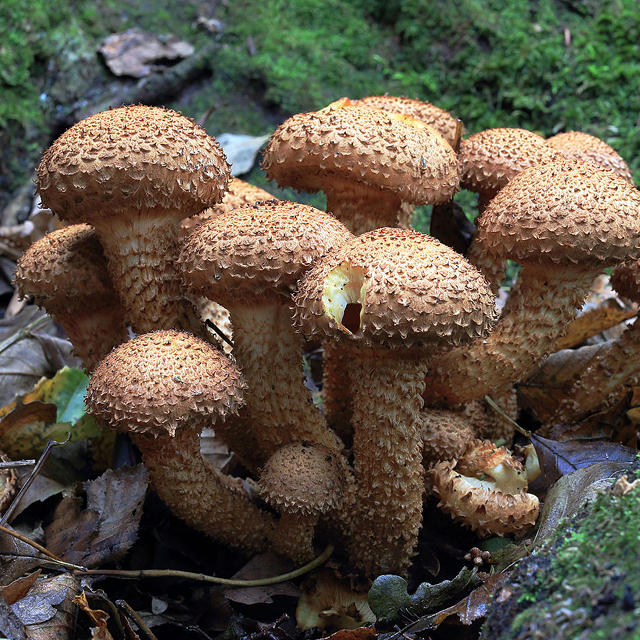
This specimen of the mushroom kingdom also has nothing to do with mushrooms. Nevertheless, among the people the nickname "royal honey agaric" stuck behind it, so I will still mention it.
It was called "royal" primarily for its appearance - the mushroom looks very impressive and photogenic, has a beautiful bell-shaped cap and is covered with large scales, the pattern of which vaguely resembles a royal robe.
As for the taste, here the opinions of mushroom pickers were divided. Some consider this mushroom tasteless, others, on the contrary, praise and value it above the usual autumn honeydew. The fleecy flake has a pronounced "rare" taste and smell.
"Royal honey agaric" grows in any forests - on stumps and trunks of old trees on decaying wood. Bears fruit with mid-August to late autumn.
Growing on stumps
The best place to start a plantation will be areas where there are stumps of spruces, pines, aspens or birches. The favorable period for planting work is from May to August. The wood on the stumps must have a high level of uniform moisture in the outer and inner layers. In any case, it will be useful to carry out additional moisturizing on your own. This is done a day or two before sowing, watering the stumps in moderate doses and introducing moisture gradually so that it can stay on the surface of the wood.
You should also pay attention to the symptoms of tinder fungus infection and do not use stumps for planting mushrooms, if these signs are present.
As a seed, you can use the fruit bodies of honey agarics themselves (spore method) and particles of wood affected by them.
Spore method
With this technology, caps of overripe specimens with a diameter of 8 to 12 cm with a dark brown bottom are used to inoculate stumps. The optimal amount for obtaining seed is 10-20 caps. They are poured with a bucket of water and left for 12-24 hours. It is better to use rainwater and not take it from stagnant reservoirs. Then the caps must be gently kneaded directly in water until a homogeneous mass is obtained, stir and filter the mushroom infusion.

On the sides and ends of the stumps, 5-10 depressions with a diameter of 2-3 cm and a depth of up to 5 cm are made, placing them in a checkerboard pattern. The resulting chatterbox from the spores is poured there. In the same way, the mass deposited on the filter is also used for sowing, filling the recesses with it.
To ensure the amount of spores required for the formation of mycelium, 0.5-1 l of mushroom suspension is usually consumed per stump. After inoculation, to maintain a stable humidity, the holes are sealed with pieces of moss or wet sawdust, the ends are left open.
This cultivation technique does not always give good results: when inoculated with spores, the mycelium of the mushroom develops rather slowly, active growth is observed only a few months after laying.
Growing with wood fragments
More successful results when growing honey agaric are given by inoculation with mycelium on pieces of wood from stumps, where the mushroom grows en masse.Planting is carried out during the entire growing season of the mushroom (except for hot, dry days), but preferably in spring or autumn.
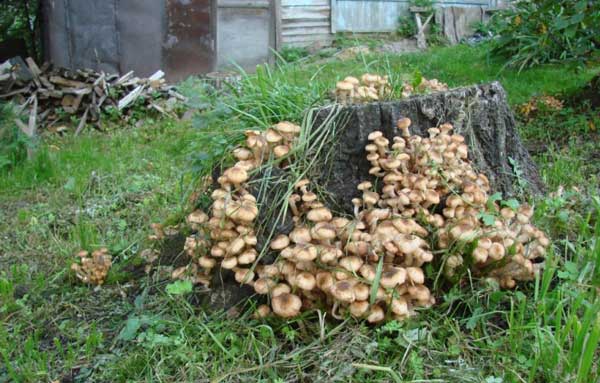
Particles of wood with mycelium are removed from the zone of the most active growth of honey agaric, they are transferred to prepared hemp on the site, laying in recesses at the ends and side surfaces of the stump. Depending on the size of the grafting wood, holes are made, taking into account that when sowing, they should be deepened by 2-3 cm from the surface. The holes are sealed with sawdust. The end of the stump is covered with polyethylene and pressed down with a brick to maintain the moisture of the top layer. The fruiting bodies of the honey fungus appear in a year or two after inoculation, the fruiting of the fungus lasts from 5 to 8 years or until the stump is completely destroyed.
For the winter, the stumps are covered with spruce branches, while in the spring, melt water should not fall on its end. Before the fruiting of mushrooms, spruce branches are removed: for summer mushroom in early June, for autumn - at the end of July.
Application in traditional medicine
Medicines (decoctions, infusions, tinctures) are prepared from foliot, which are used by traditional healers in the treatment of diseases of the cardiovascular system (atherosclerosis, arterial hypertension, varicose veins, thrombophlebitis). Iron and magnesium foliot contribute to an increase in hemoglobin levels, so the introduction of these mushrooms into the diet will be beneficial for anemia and thyroid diseases.
Due to their low calorie content, royal mushrooms are included in the diet of diabetics, vegetarians and people on a diet. It is scientifically proven that the extract of fresh golden foliot inhibits the growth of Ehrlich's carcinoma and sarcoma-180 in laboratory mice.
We offer you to familiarize yourself with Where did the potatoes come from?
In cooking, only ordinary, golden, gummy foliots and honey mushrooms are used, because they have a pulp with a pleasant smell and a typical mushroom taste, similar to the taste of real mushrooms.
These mushrooms can be cooked in a variety of ways:
- add to soups, main courses, baking fillings, sauces and salads;
- fry;
- marinate;
- salt.
It is not customary to dry the flakes.
Preparing fresh foliots is not worth it: they can cause dyspeptic symptoms. Before cooking, royal mushrooms must be boiled so that these digestive problems do not arise. The broth of the mushrooms must be drained.
You can eat the entire fruiting body of the mushroom, but experienced chefs recommend taking caps for hot dishes, and the whole body for pickling and pickling.
Characteristics of the scaly fungus
Royal mushrooms (golden scales) justify their name, which is very common among the people, completely. The caps of these mushrooms can reach 20 centimeters in diameter, and they sometimes reach a height of 15-20 centimeters (see photo). These giant mushrooms in the scientific literature are called golden flakes.
These mushrooms grow mainly one at a time, which differs from ordinary honey agarics, Japanese nameko mushrooms and other scales, which prefer to grow in numerous colonies.
Small groups of royal honey mushrooms are quite rare, but mushroom pickers do not always collect them, although in taste they do not differ at all from such usual and beloved by many ordinary mushrooms.
Golden mushrooms, with caps covered with brown scales, grow on living trees, stumps and deadwood in deciduous forests, most of them appear in the fall, before a cold snap.
Beneficial features

Due to the variety of trace elements and amino acids, and with a low calorie content, mushrooms are especially useful for vegetarians, everyone who follows a low-calorie diet, and believers who observe many days of church fasts.
There is so much phosphorus and calcium in royal mushrooms that they can compete even with fish.
In terms of nutritional value, royal mushrooms belong to 4 categories, and that is why in many European countries they are considered inedible, therefore they are rarely eaten.In Russia, along with the usual honey agarics, rich in vitamins and at the same time very tasty, is used in the preparation of many dishes, the recipes of which have been known for a long time.
In order for the mushrooms not to cause digestive problems and indigestion, they must first be boiled.
After that, you can cook delicious soups from them, fry, prepare filling for pies and vegetarian pizzas, add to various vegetable stews and stew.
For these dishes, it is recommended to take only caps, but mushroom legs are also marinated perfectly. Royal mushrooms are great for salting and add a spicy taste to various salads.
In addition, the use of golden flakes helps prevent the onset and growth of tumors.
The harm of royal mushrooms (golden scales), like any mushrooms, is that it is undesirable to eat royal mushrooms for people with a sick stomach and those who have food allergies to mushrooms.
Pulp
The pulp is fleshy, compact or thin, with a bitter taste.
The stem is cylindrical in shape, the surface is dry or slimy, scaly or smooth.
Edible and conditionally edible mushrooms, similar to honey agarics
The harvested honey agaric can be frozen fresh for the winter or after preliminary heat treatment.
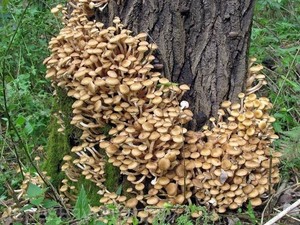
Also pre-sort mushrooms by size, discard with damage and rot. You can freeze in bags with fasteners, in plastic containers. Arrange the mushrooms in one layer, with a large amount, they will simply stick together and lose their shape when thawed. Once frozen, they can be stored for 6 months at -18 degrees.
Freezing honey agarics with preliminary heat treatment
Honey mushrooms are prepared before freezing in one of three methods: blanch, boil or fry. After processing, honey mushrooms are stored for 3-4 months.
The ability to distinguish the “good” gifts of the forest from the “bad” ones are vital, since the health and life of people who eat them depend on it.
Young specimens are characterized by rich reddish color. Elastic firm pulp is not changes its color if damaged. Such fruits grow singly or in groups in deciduous or mixed forests from mid-summer to late autumn.
Scale is a semi-edible species and contains substances that have a beneficial effect on the human body. It is used in medicine to treat gout and other joint diseases.
Other
The yellow-red row can be found from late summer to the first half of autumn on dead woods in coniferous forests. There are scales on her hat... In addition to the bright color, a characteristic external sign is the absence of a ring under the cap. Such a mushroom must be soaked before use, and also boiled.
 Row yellow-red
Row yellow-red
Edible meadow mushrooms can be consumed in almost any form without danger to health. From summer to mid-autumn, they are found in forest glades, meadows, and gardens. Externally, small mushrooms with a light brown cap and thin stem are distinguished by a pronounced mushroom aroma.
Meadow mushroom occurs from early summer to late October in open areas, roadsides, forest glades, in gardens. This small mushroom (6 cm high) tastes great, so is very popular among mushroom pickers.
Types of scaly fungus
In total, more than 140 species are known, while only 30 are found in Russia. The most common of them are described below.
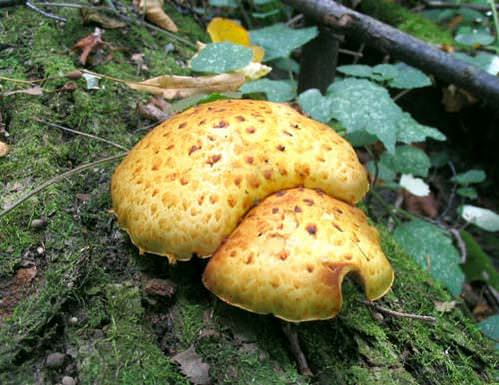
In color - different shades: from orange to red and brown. It is not very large in size: the diameter of the cap is within 10 cm, the height of the leg is up to 12 cm. It has no special smell.
NOTE
The scales that run along the outside of the cap have red tints, so from a distance it may seem as if the mushroom has characteristic holes. Most often they settle on deciduous trees - along with willows on alder, less often - on birch and conifers.Mushrooms are edible, but they need preliminary processing (for more details, see the corresponding section).
In Japanese, this variety is called "nameko", which literally translates as "slippery mushrooms." They are very reminiscent of honey agarics - they grow in large nests, have a similar orange-brown color and even shape are pretty similar.
The recipe is simple, but the taste of the soup turns out to be very rich - the combination of delicate cheese and pronounced mushroom aroma gives a very good combination:
- The potatoes are cut into small cubes, and the carrots are grated on a coarse grater. Chop the onion finely enough.
- The potatoes are sent to a saucepan and cooked over medium heat. Finely chopped mushrooms are immediately placed there.
- Carrots and onions are fried until cooked.
- When the potatoes are fully cooked, add onions and carrots to them, being careful not to pour out excess oil. At the same stage, salt is added to taste.
- Now you need to bring everything to a boil again and drain all the contents through a sieve, rubbing all large fragments in mashed potatoes.
- Finely grated processed cheese is added to the finished soup.
- Finely chopped greens are added. It would be appropriate to put croutons, which are better made from a dried baguette (you can fry with garlic) - then the dish will turn out in the best French traditions.
We offer you to familiarize yourself with Mushroom places of the Leningrad region 2020
Thus, experienced and novice mushroom pickers should include flakes in their menu. These are not only tasty, but also healthy mushrooms that will come to the summer and winter tables. Bon Appetit!
What do the false ones look like?
The color of the inedible moth is much brighter than that of its edible "relative"; nature has made sure that the fruit attracts attention with its appearance. As for the aroma that the false mushroom exudes, it can hardly be called mushroom or pleasant.
To all this, the surface of the cap of a dangerous plant is covered not only with scales, but also with a thin layer of mucus, if dampness prevails on the street.
As for the aroma that the false mushroom exudes, it can hardly be called mushroom or pleasant. To all this, the surface of the cap of a dangerous plant is covered not only with scales, but also with a thin layer of mucus, if dampness prevails on the street.
A few more doubles of the royal delicacy are cinder and slimy flakes.

The first is distinguished by a too bright, orange cap, the absence of a ring around the leg and the presence of scraps of skin along the edges of the cap. The second is a bell-shaped, slightly concave head shape and sticky flesh.
Well, another dubious representative of the flake family - the "ordinary" species
You can eat it, but only if you follow certain rules, with extreme caution
The filling for baking can be supplemented with boiled potatoes or rice.
Ingredients:
- flake - 700 g;
- flour - 1000 g;
- milk - 500 g;
- butter - 100 g;
- onions - 2 pcs.;
- chicken eggs - 2 pcs.;
- sugar - 50 g;
- vegetable oil - 50 ml;
- fresh yeast - 30 g;
- salt to taste.
- Dissolve yeast in warm milk, sift 500 g flour. Mix the food, cover the dough with a towel and heat it for 30 minutes.
- Add eggs, melted butter, salt and sugar. Add the remaining flour.
- Knead the dough and let it stand warm for 2.5-3 hours.
- Boil the mushrooms, drain the broth. Cut the onion into half rings. Fry the prepared foods in vegetable oil, salt the filling to taste.
- Mince the mushrooms and onions.
- Divide the dough that comes up into lumps with a diameter of 5 cm, roll them out with a rolling pin to a thickness of 1 cm.
- Place 1 tbsp on the flatbread. l. fillings, blind pies.
- Place the pieces on a baking sheet and brush with a beaten egg.
- Bake the treat for 30 minutes at a temperature of 200 ° C.
We suggest that you familiarize yourself with How to prepare pickle for cucumbers
Serve baked goods with tea or milk.
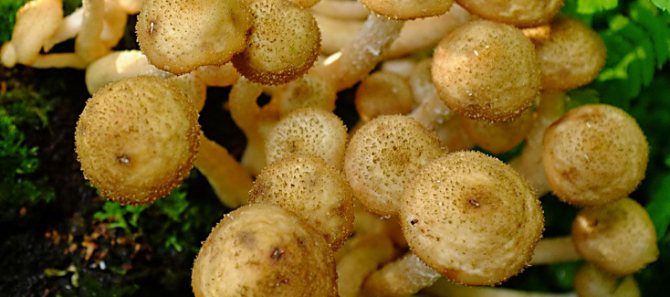
Boiled mushrooms can be used to decorate festive salads and snacks.
Types of honey agarics
In the forest, you can find different types of honey mushrooms, very tasty and healthy.
Summer
As the name implies, summer mushrooms love a warm climate. In places where the optimum temperature for them is constantly maintained, mushrooms can grow all year round. They grow on deciduous trees and firs, hemp and logs.
The mushrooms reach a height of no more than 7 cm. The hat is painted in the usual color for all mushrooms, but in the middle it has a light speck. The cap and leg are covered with red scales, and on the latter one can see a small filmy skirt.

Autumn
Autumn mushrooms prefer to grow on live trees or shrubs. They grow up to 10 cm. The mushroom cap is thickened, scaly, fibrous at the edges. Interestingly, the color of the mushroom depends on the tree on which it grew. For example, dark gray mushrooms grow on an elderberry, on oak - brown, and on a pine or other coniferous tree - brownish-red.

Winter
Mushrooms - lovers of cold climates most often live on dead or damaged trees, preferring willow or poplar. Honey mushrooms grow up to 7 cm and are distinguished by a specific velvety brown leg. The hat is brown or orange, flattened, has a dense structure.

Lugovoi
Meadow honey agaric is another representative of edible mushrooms. Its distinguishing feature is the way it grows: these mushrooms form clear, even rows, which are sometimes called "witch's circles".
On average, a meadow mushroom grows by 10 cm. Its cap is dense, slightly widened downwards. In rainy weather, the mushroom becomes sticky, and the color of the cap can change from normal to reddish.
The leg of the meadow honey fungus is covered with plates, and the pulp is light, soft and tender.

Fatleg
Such a mushroom can be recognized by its small stature. Its leg is flattened, low and straight. Large dry brown scales are generously scattered throughout the mushroom.
The cap of the mushroom is large enough - up to 10 cm in diameter, brownish-brown, beige and convex. You can also recognize the mushroom by its smell: thick-legged honey mushroom has a light cheese aroma.

Spring
Favorite places of spring honey agarics are decaying foliage and fallen trees in oak or pine forests.
The honey agaric is decorated with a straight slender leg of light brown color and a convex, reddish-brown cap. Small plates covering the mushroom have a whitish-pink tint.

Garlic
The mushroom got its name for the characteristic smell of garlic. In cooking, it is often used not only in the preparation of main dishes, but also as a seasoning.
You can recognize the mushroom by its dark brown, thin and dense stem. The mushroom cap is wide, convex. It is light at the edges, and darkens towards the center, acquiring a brownish color.

Where do autumn royal mushrooms grow?
It should be noted that edible species of royal honey agaric grow on damaged tree trunks, old, long-felled stumps. They can also be found on the ground next to the roots of dead deciduous and coniferous species. Fruiting of golden scales or royal honey agarics begins in August and continues until the end of September... Residents of the Primorsky Territory can pick these amazing mushrooms from mid-May to mid-September.
Where else do royal mushrooms grow, and which trees are preferred most? Usually this species of honey agaric settles on the trunks of deciduous trees, especially on alder or willow, sometimes it chooses birch and birch stumps, less often - coniferous trees in swampy areas. Take a look at the photos below showing what the royal mushrooms look like on the trees in the forest:
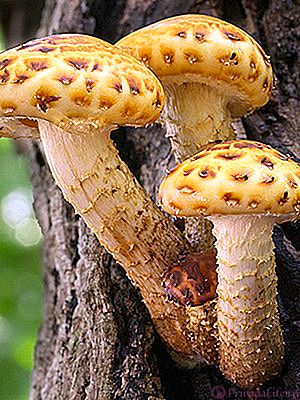
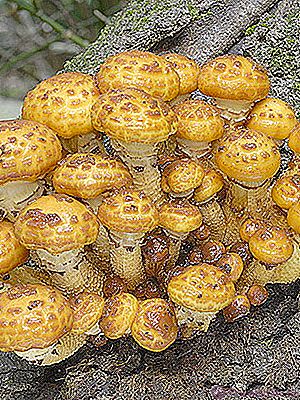
Sometimes even experienced mushroom pickers, due to the rare appearance of golden scales, confuse them with false mushrooms that grow in the same territories. Therefore, we suggest that you carefully read the photos of edible and false royal mushrooms:
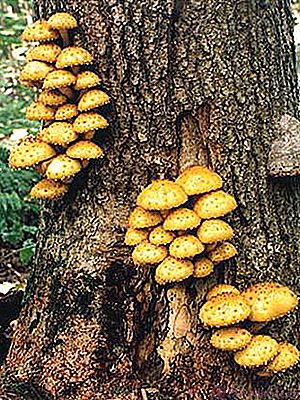
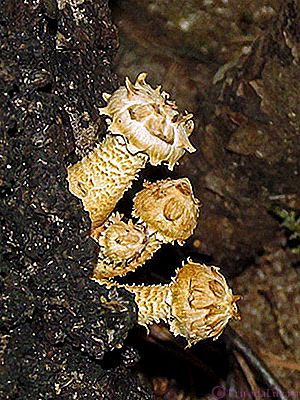
As already mentioned, scales or royal mushrooms are edible mushrooms. However, before using it, it must be boiled in salted water for 20-25 minutes.Since royal mushrooms have excellent taste, they are used in appetizers, salads, first and second courses. Especially great flakes are combined with fried or boiled potatoes. In addition, many housewives make preparations for the winter from these mushrooms: they pickle, salt, freeze and dry.
Sometimes honey agarics can be found in pine forests and spruce forests. What does a royal mushroom look like if you find it in a coniferous forest? Usually, flakes collected in deciduous forests are different from those growing in conifers. The first difference between honey agarics found in pine forests is the dark color of the cap and scales, and the second is the bitter taste. However, royal mushrooms contain a lot of vitamins C, PP and E. In addition, there are only 22 calories per 100 g of flake, so the calorie content of this species is very low. That is why they are useful for vegetarians and those who follow a low-calorie diet. In terms of the content of phosphorus and calcium, royal mushrooms even compete with fish.
Experts ranked royal mushrooms in the IV category of edibility. That is why in other countries they are not eaten and are not even harvested, since this category abroad refers to inedible species. However, in Russia they are prepared in the same way as ordinary autumn mushrooms. They are first boiled in salted water and only then the first courses are fried, stewed or cooked. In addition, royal autumn mushrooms are used in other culinary recipes: they prepare mushroom stew, julienne, make caviar, pates, sauces, hodgepodge and mushroom fillings for pizzas and pies.
Although golden scales are widespread on Russian territory and is well recognizable, it is not collected so often. Perhaps this is due to the fact that very few people are familiar with this type of mushroom. However, true connoisseurs of mushroom delicacies put it on a par with autumn mushrooms and even boletus mushrooms. We offer you to watch a video of collecting royal honey agarics in deciduous forests by lovers of "quiet hunting":
Growing honey agarics at home on stumps
In your own garden or in your summer cottage, you can grow mushrooms on the stumps of deciduous trees: birch, poplar, aspen, apple, pear. The main thing is that the stump chosen for breeding is not affected by rot or tinder fungi. 2-3 days before the introduction of the mycelium, it is necessary to periodically moisten the stumps with water.
You can use both purchased mycelium and self-collected forest material. To do this, you need 10-12 mushroom caps, which must be poured with a bucket of rain (river, lake) water and kept like that for a day.
The present hats are kneaded with hands into a gruel, which is filtered through several layers of gauze. The resulting spore solution is poured over the end and side parts of the selected and prepared stump. To increase the likelihood of stump infestation with mycelium, it is recommended to make small holes with a diameter of 2 cm in the wood at a distance of 4 cm from each other. It will be much more convenient if the holes made are staggered. These depressions are additionally filled with spore gruel and covered with moss or sawdust. In this case, the end of the hemp is left open. Growing mushrooms in this way, you can get the first harvest of honey agarics in 2 years (Figure 5).
It is necessary to know that the mycelium of the fungus can infect other healthy trees in the immediate vicinity of an infested stump. Therefore, you need to take protective measures by digging in the infected stump with a ditch 30 cm deep and 10-15 cm wide at a distance of 2 m around it.
Figure 5. Features of growing honey agaric on stumps
The cultivation of honey agarics can also be carried out using wood sticks infected with mycelium, which are inserted into the prepared holes on the stumps. This procedure is carried out in April-May, when the sun is already active enough and can dry out the mycelium. Therefore, it is recommended to cover the inhabited stump with a layer of straw or dry grass. For the winter, the stump must be covered with spruce branches.In snowy weather, regularly shake off the snow accumulated on the branches, and with the arrival of spring, make sure that melt water does not fall on the end of the stump, since this greatly inhibits the development of the mycelium, which means that you will get the harvest much later.
How to distinguish royal mushrooms from false mushrooms (with photo)
Often, royal mushrooms are called willow, since it is on the willows that it is harvested. These mushrooms grow practically from mid-summer until frost. Inexperienced mushroom pickers may confuse an edible mushroom with an inedible moth. How to distinguish royal mushrooms from false inedible mushrooms? False honey moth grows only on the ashes, as well as old fireplaces, overgrown with grass and shrubs. Has a bright color, bitter taste and unpleasant odor. Although the pulp is juicy and firm, it is not eaten due to its smell. The fungus can pose a serious health hazard. Therefore, we propose to compare the photo of the royal honey and the false one:


There are several more royal species of honey agarics, which are considered conditionally edible.
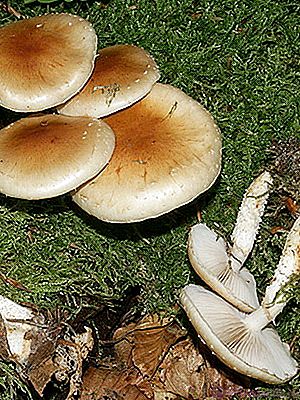
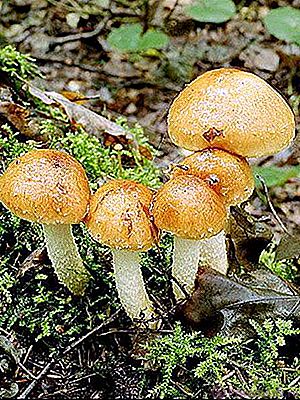
For example, slimy scaly, which is very similar to the royal golden scaly. The caps of young mushrooms have a bell-shaped shape, which becomes concave as the mushrooms grow, and the edges of the cap rise. If the weather is rainy, then the pulp becomes slimy and sticky, which was the name for scaly - slimy. The stem of this mushroom becomes hollow over time, and the ring on the stem disappears completely. Slimy scales grow only on decayed wood from mid-August to early October.

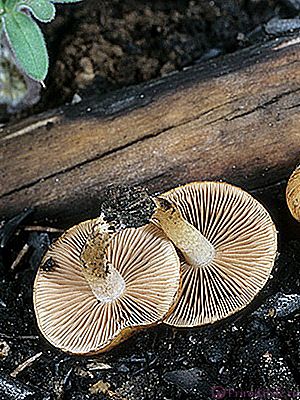
Another false royal honey fungus - cinder flakes, is considered inedible. The shape of the cap at a young age of the fungus is hemispherical, and in mature it becomes completely spread. The color of the cap is very bright - orange-brown, the edges are covered with scraps of bedspread. The stem of the scale, especially its lower part, is densely covered with brown fibers. The ring inherent in real mushrooms is not visible at all on the leg.
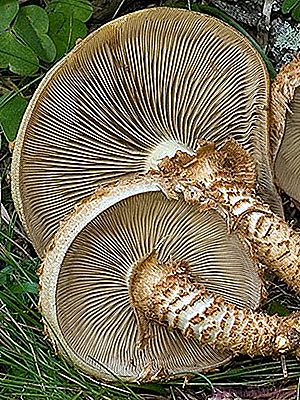
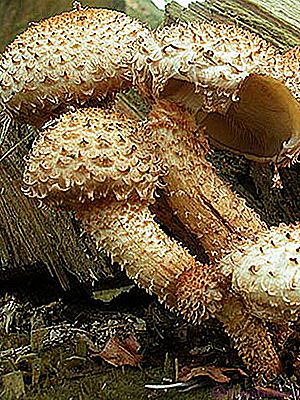
Common flake is considered conditionally edible, which is similar to royal mushrooms of honey agarics. Although it has healing properties, it still has one drawback - hallucinogenicity. You can eat it, but only after a long heat treatment. Boil this species for at least 40 minutes and only then eat. Collect this type of mushroom very rarely, usually only those who know how to cook it. After all, experienced mushroom pickers know that it is strictly forbidden to consume ordinary flakes with alcohol. Opium contained in this form, in interaction with alcohol, can have unpredictable consequences for the body.To know how to distinguish royal mushrooms, we suggest looking at photos showing these differences:
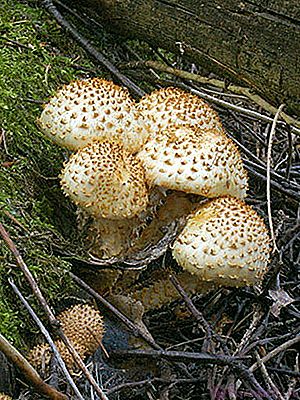

Having become well acquainted with them, you can safely go to the forest for royal mushrooms. However, if you are still not sure of your knowledge, it is better not to risk it, but to collect only those fruiting bodies that are familiar to you.

